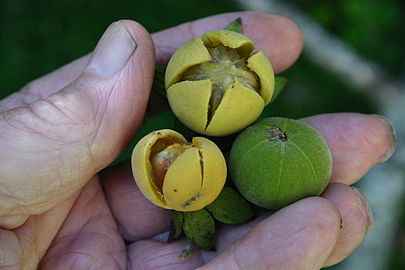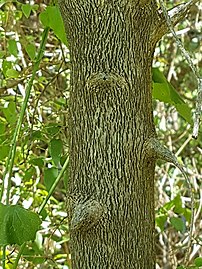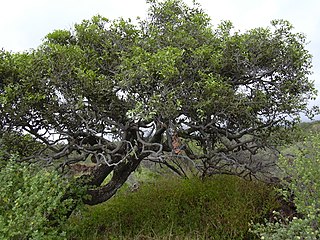
The Ebenaceae are a family of flowering plants belonging to order Ericales. The family includes ebony and persimmon among about 768 species of trees and shrubs. It is distributed across the tropical and warmer temperate regions of the world. It is most diverse in the rainforests of Malesia, India, tropical Africa and tropical America.

Curtisia dentata is a flowering tree from Southern Africa. It is the sole species in genus Curtisia, which was originally classed as a type of "dogwood" (Cornaceae), but is now placed in its own unique family Curtisiaceae.
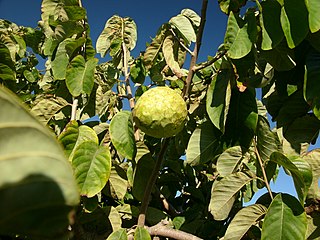
The cherimoya, also spelled chirimoya and called chirimuya by the Inca people, is a species of edible fruit-bearing plant in the genus Annona, from the family Annonaceae, which includes the closely related sweetsop and soursop. The plant has long been believed to be native to Ecuador and Peru, with cultivation practised in the Andes and Central America, although a recent hypothesis postulates Central America as the origin instead, because many of the plant's wild relatives occur in this area.
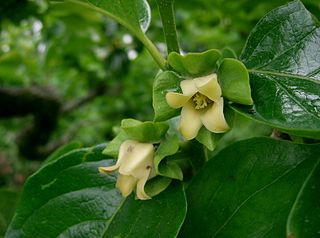
Diospyros is a genus of over 700 species of deciduous and evergreen trees and shrubs. The majority are native to the tropics, with only a few species extending into temperate regions. Individual species valued for their hard, heavy, dark timber, are commonly known as ebony trees, while others are valued for their fruit and known as persimmon trees. Some are useful as ornamentals and many are of local ecological importance. Species of this genus are generally dioecious, with separate male and female plants.

Diospyros mespiliformis, the jackalberry, is a large dioecious evergreen tree found mostly in the savannas of Africa. Jackals are fond of the fruit, hence the common names. It is a member of the family Ebenaceae, and is related to the true ebony and edible persimmon.
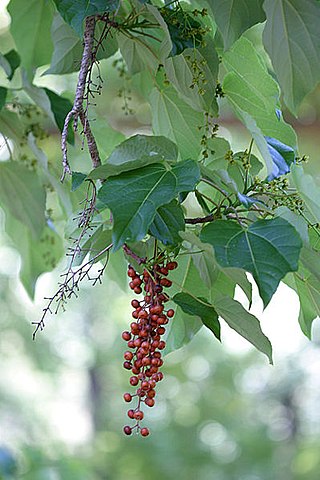
Idesia is a genus of flowering plants in the family Salicaceae, comprising the single species Idesia polycarpa. It is native to eastern Asia in China, Japan, Korea, and Taiwan.

Mimetes hirtus is an upright, evergreen shrub of 1½–2 m (5–6½ ft) high from the family Proteaceae. It has upright, overlapping, (broadly) lance-shaped leaves, without teeth, but with one thickened pointy tip. It has cylindric inflorescences topped by a pine apple-like tuft of pinkish-brownish, smaller and more or less horizontal leaves. The flowerheads are tightly enclosed by yellow, red-tipped bracts, only the 9–14 long red styles and the whitish silky tips of the perianth sticking out. It is primarily pollinated by the Cape sugarbird. It is an endemic species of the southwest of the Western Cape province of South Africa, and grows in wet zones at the base of south facing mountain slopes. Flower heads may be found from May to November, but peaks in July and August. The species has several vernacular names of which marsh pagoda seems to be used most.

Elaeocarpus bancroftii, commonly known as Kuranda quandong, Johnstone River almond, ebony heart, grey nut, or nut tree is a large rainforest tree in the family Elaeocarpaceae which is endemic to Queensland. It has coriaceous leaves, attractive white flowers and relatively large fruit containing an edible kernel.

Brabejum is a genus of a single species of large evergreen tree, Brabejum stellatifolium in the family Proteaceae, commonly called wild almond, bitter almond or ghoeboontjie. It is restricted in the wild to South Africa's Western Cape province, where it grows in thickets along the banks of streams. The plant is of botanical interest as being Africa's only member of the large grevilleoid subfamily. It is a bushy small tree with branches widely at ground level and numerous erect vigorous stems. Leaves grow up to 6 in (15 cm) long, narrow and bluntly toothed, appear at intervals along the branches, mostly in whorls of 6. In summer, the plant bears white flowers densely crowded on spikes arising from rusty buds at the leaf axils. The fruits to 2 in (5 cm) long, magenta to reddish brown, similar to an almond, appear in autumn. The nut is too bitter to eat; however, in earlier times it was boiled, roasted, and ground to make a "coffee" drink.

Diospyros texana is a species of persimmon that is native to central, south and west Texas and southwest Oklahoma in the United States, and eastern Chihuahua, Coahuila, Nuevo León, and Tamaulipas in northeastern Mexico. Common names include Texas persimmon, Mexican persimmon and the more ambiguous "black persimmon". It is known in Spanish as chapote, chapote manzano, or chapote prieto, all of which are derived from the Nahuatl word tzapotl. That word also refers to several other fruit-bearing trees.

Millettia grandis is a species of plant in the family Fabaceae from South Africa. It is commonly called umzimbeet which is a name derived from the isiZulu name umSimbithwa.

Leucospermum conocarpodendron is the largest species of the genus Leucospermum, reaching almost tree-like proportions of 5–6 m (16–20 ft) high with a firm trunk that is covered in a thick layer of cork that protects it from most fires. It has greyish or green narrow or broad inverted egg-shaped leaves with three to ten teeth near the tip and large yellow flowerheads, with firm, bent, yellow styles that stick far beyond the rest of the flower and give the impression of a pincushion. It is commonly known as the tree pincushion in English or goudsboom in Afrikaans. They naturally occur near Cape Town, South Africa.

Inocarpus fagifer, commonly known as the Tahitian chestnut or Polynesian chestnut, is a species of flowering plant in the subfamily Faboideae of the legume family, Fabaceae. The tree has a wide range in the tropics of the south-west Pacific and south-east Asian regions, and a history of traditional use by the peoples of Polynesia and Melanesia. It is the only edible and culturally important member of the genus Inocarpus.

Moringa stenopetala, commonly known as the African Moringa or cabbage tree, is a deciduous tree in the plant genus Moringa, native to Kenya and Ethiopia. A drought-resistant species, it is characterized by its bottle-shaped trunk, long twisted seed pods, and edible leaves likened to cabbage, from which its common name is derived. M. stenopetala is extirpated in the wild in Ethiopia, though still grown there as a crop on the terraces of the Ethiopian Highlands, mainly in the Konso region.

Osyris compressa is a facultatively hemiparasitic, mainly South African plant of the sandalwood family, Santalaceae. Until recently, the favoured binomial name was Colpoon compressum, but around 2001, the genus Colpoon was included in Osyris on the basis of comparative DNA studies. That assignment is not final, however, and according to the Kew Gardens plant list, Colpoon compressum P.J.Bergius, though still in review, is the accepted name.

Mimetes fimbriifolius, also called cowl pagoda or the fringed pagoda, is a species of plant in the family Proteaceae. It is a dense, rounded, multi-branched tree that grows up to 4 metres in height. This attractive and striking plant flowers all year round, and produces red and yellow branch-heads and inflorescences. The nectar-rich flowers are pollinated by sunbirds and the seeds are distributed and taken underground by ants before germinating. It is endemic to the Table Mountain range in the city of Cape Town, South Africa.

Diospyros revaughanii is a rare species of tree in the family Ebenaceae (ebony).
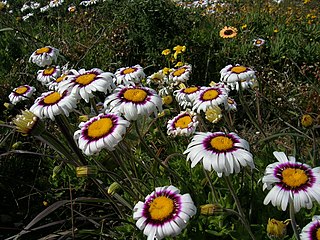
Felicia elongata is a perennial plant of up to 40 cm high that is assigned to the family Asteraceae. It has stiff, oval, opposing leaves with one distinctive vein and entire margin. The 5 cm (2 in) wide flower heads are very conspicuous in colour, white with a dark purple zone at the base of the ray florets and an orange-yellow disc. Flowering occurs from late August to September, or if the rains arrive late, sometimes October. It is a rare species that is restricted to the Saldanha Bay area. It is sometimes called Saldanha felicia or tricolour felicia in English, and driekleurblommetjie in Afrikaans.
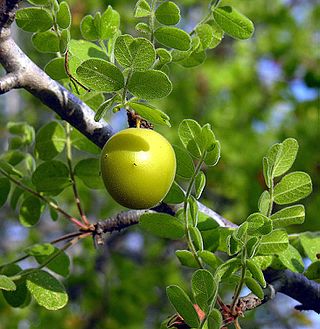
Cyrtocarpa edulis is a species of perennial sarcocaulescent tree commonly known as the Cimarrón plum or Cape wild-plum. It is in the genus Cyrtocarpa, and is endemic to Baja California Sur. This plant is characterized by fleshy stems, twisted branches and an edible drupe.

Diospyros paniculata, or the panicle-flowered ebony, is a species of tree in the ebony family. Endemic to the Western Ghats area of India and parts of Bangladesh, the species is currently listed as Vulnerable in the IUCN Red List.

